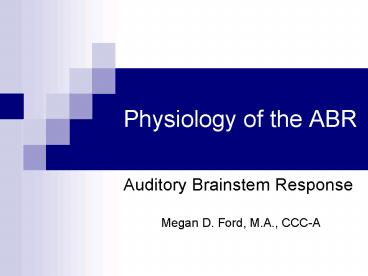Physiology of the ABR - PowerPoint PPT Presentation
1 / 20
Title:
Physiology of the ABR
Description:
Needham Heights, MA: Allyn & Bacon; 1992 ... Needham Heights, MA: Allyn & Bacon; 1994. Scott M: Auditory Brainstem Response Audiometry. ... – PowerPoint PPT presentation
Number of Views:124
Avg rating:3.0/5.0
Title: Physiology of the ABR
1
Physiology of the ABR
- Auditory Brainstem Response
- Megan D. Ford, M.A., CCC-A
2
Sullivan, 2000
3
Auditory Brainstem Response(ABR)
- Waveforms of ABR first labeled with Roman
numerals by Jewett and Williston (1971). - The summed responses of the synchronous firing of
large numbers of VIIIth nerve and auditory
brainstem neurons.
4
Auditory Brainstem Response(ABR)
- By measuring the amplitude and latencies of each
of the five major waves of the ABR, one can
objectively estimate hearing levels, screen for
retrocochlear pathology and monitor the VIIIth
nerve intraoperatively.
5
Auditory Brainstem Response
- Click or toneburst stimuli generate a response
that travels the auditory pathway - The response is measured using surface electrodes
and plotted as five peaks and troughs - The positive peaks are generated from multiple
axonal pathways in the auditory brainstem
6
(No Transcript)
7
Components of the ABRWaves I and II
- True action potentials
- Wave I (AKA AP action potential of the EcochG)
generated from distal portion of the VIIIth nerve - Specifically, VIIIth nerve firing due to activity
in the basal portion of the cochlea - Wave II generated from the proximal VIIIth nerve,
as it enters the brainstem
8
Components of the ABR Wave III
- Second-order neuron activity
- Peak comes from in or near the cochlear nucleus
- Trough arises from the trapezoid body
- Generated in the caudal portion of the auditory
pons
9
Components of the ABR Wave IV
- Often seen tagging along on Wave V
- Arises from pontine third-order neurons, mostly
located in the superior olivary complex - Contributions from cochlear nucleus and nucleus
of the lateral lemniscus
10
Components of the ABR Wave V
- Positive peak related to the termination of the
lateral lemniscus as they enter inferior
colliculus - Negative trough attributed to dendritic
potentials within the inferior colliculus
11
Lets not forget the Cochlear Microphonic
- An alternating current potential that mocks the
stimulus - Not to be confused with stimulus artifact
- Arises from the outer hair cells
12
Cochlear Microphonic
Can be seen by alternating the polarity of the
stimulus (Rarefaction versus Condensation)
Berlin, et al, 2002
13
Interpreting the Results
Yoshinaga, et al, 2003
14
Evaluating the ABR response
- Analyze the absolute latency of wave V and
compare to - Normative data
- The other ear (Interaural difference)
- Results that fall out of the normal range suggest
retrocochlear pathology
15
Evaluating the ABR response
- Analyze interpeak intervals (I-III, III-V, I-V)
and compare to - Normative data
- The other ears interpeak intervals
- Results that fall out of the normal range suggest
retrocochlear pathology
16
Evaluating the ABR response
- Absent response in the involved ear
- Absent wave I usually correlates with cochlear
pathology - Absent wave III-V or absent ABR is suggestive of
retrocochlear pathology
17
Evaluating the CM response
- When CM is present in the absence of ABR
waveforms, may indicate auditory neuropathy - Often, a present CM correlates with robust
oto-acoustic emissions
18
Considerations in Interpretation
- Many factors affect the ABR response
- Degree and type of hearing loss
- Intensity of signal
- Rate of the signal
- Type of signal (click versus toneburst)
- Recording montage
- Pathology
19
Bibliography
- Hall JW III Handbook of Auditory Evoked
Responses. Needham Heights, MA Allyn Bacon
1992 - Jacobson J Principles Applications in Auditory
Evoked Potentials. Needham Heights, MA Allyn
Bacon 1994 - Scott M Auditory Brainstem Response Audiometry.
eMedicine. http//www.emedicine.com/ent/topic473.h
tm 2005 - Webster D Neuroscience of Communication. San
Diego, CA Singular Publishing 1995
20
fordm_at_ummhc.org
- Questions?































